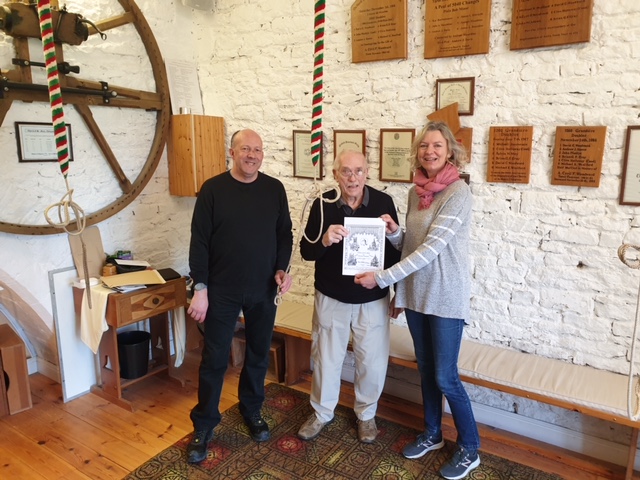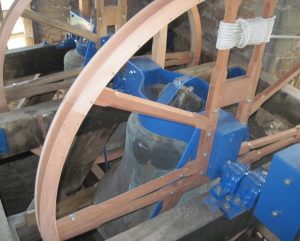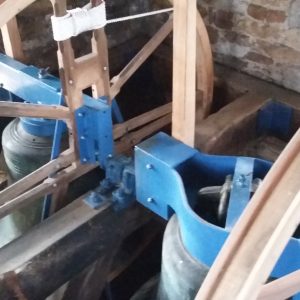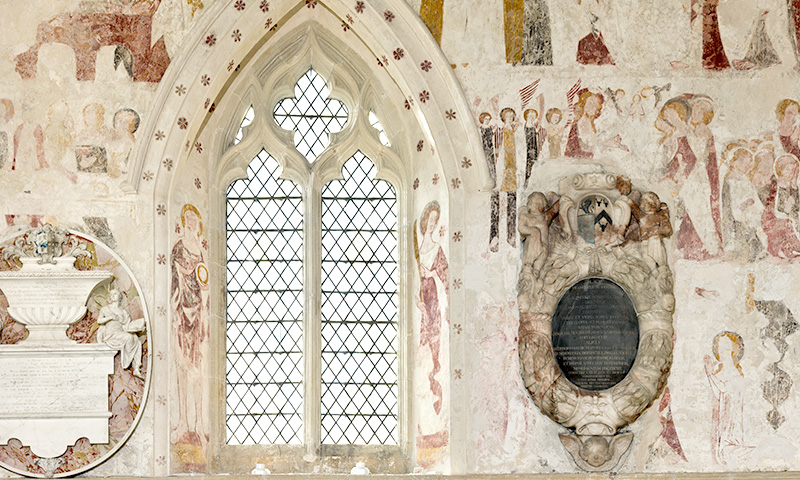The Tower
Bellringers
At St Mary’s Chalgrove we practice from 7.30 – 9.00pm every Wednesday. Whilst teaching complete novices or for forthcoming special events we will occasionally start at 7.00pm. If a novice is being taught on their own we tend to fit a silencer to the bell. We ring for most Sunday services, weddings and other special events.
If you are interested in becoming a bell ringer then please contact the Steeple keeper, Andrew Davis on 01865 890755.
Christine Wasmuth recently returned to bell ringing after a break of 25 years. Proposed as a member of the Oxford Diocesan Guild of church bell ringers, here she is receiving her membership certificate from Tower Captain Brian Gray and Steeple Keeper Andrew Davis.

The Clock
The clock, deliberately, has just one hand! It was installed in 1802, although the movement is dated 1699. Evidence suggests that the numbers on the face refer to the date 1863 when the present clock face was installed. The clock was renovated in 1996. The clock face and hand were refurbished again in 2013.
The clock and striking mechanisms are hand wound twice weekly by the steeple keeper and a small team of assistants.
Bells
The six bells at St. Mary’s are hung in a beautifully crafted oak frame and were re-hung in 2010. Three of the bells date from 1664, two from 1729 (Listed because of their historical importance), and the smallest from 1888. The largest, the tenor, is the one that strikes the hour. There is a little additional “Ting Tang” (Sanctus) bell, the earliest, which dates from 1652 which can be rung before services.
The bells were taken down in July 2010, refurbished and then replaced in November that same year. Andrew Davis’ full account of the project is given below, along with details of the re-dedication of the bells by the Bishop of Dorchester on 23rd January 2011.
Hear the ‘Old’ and the ‘New’
To celebrate the “ringing out of the old (unrefurbished) bells”, a Quarter Peal of 1260 Grandsire Doubles was rung on Friday evening 2 July 2010 by a band comprising of Brian Gray, Andrew Davis (conductor), Gordon Smith, Wendy Simon, Jeanette Barrington and Judy Kidman. You can hear the last five minutes of this peal here:
On Sunday 30th January 2011 the bellringers rang a Quarter Peal of 1260 Changes of Grandsire Doubles. This was the first quarter peal rung by members of the Parish following the rehanging and rededication of the bells at St. Mary’s Chalgrove. We are pleased to report that they ring so much better! The band was Judy Kidman – Treble, Jeanette Barrington – 2, Wendy Simon – 3, Brian Gray – 4, Andrew Davis – 5 (Conductor), Mark Wasmuth – Tenor.
Here are the last five minutes of the peal. Can you tell the difference between the before and after bells?
St. Mary’s Chalgrove Bell Refurbishment and Re-hanging 2010
At St Mary’s we have a team of 15 ringers. Three of our bells the 2nd, 3rd and 4th are listed in the “Schedule of Bells for Preservation”. The ring of six bells is hung in a beautifully crafted oak frame, having been re-hung in 1888. Some minor work was also carried out in the 1970s including fitting two RSJs to support the frame.
Over the last few years the bells had become very awkward to ring, with only the brave able to handle the heavier bells. As they are so hard, it makes it very difficult to train new ringers. It has always been our aim to encourage younger and less able bodied people to join us in learning the art of Bell ringing. To this end we sought a quote for works to include tuning and re-hanging the bells on new bearings and fittings. We planned to do all the initial pre-work ourselves, and to provide labour for the main works to reduce costs. The initial price we received from Whites the Bell hangers was £26.5K. This price did not include any pre-work costs. There followed many months of work seeking approvals before the PCC agreed to proceed with the project.
On the 2nd July 2010 the last quarter was rung on the bells of St. Mary’s Church Chalgrove prior to their refurbishment (see above). This was followed by a final practice night on the 14th where we were joined by Ian our Vicar who proposed a toast to the future success of the project.
At 1pm on Friday 16th July, after nearly three years preparation, work commenced. We spent the afternoon and Saturday removing the fittings from the bells and ensuring that all of the tower trapdoors could be opened. A large opening was formed in the floor of the belfry, to allow plenty of room to squeeze the Tenor through.
Scaffolding went in the following Tuesday morning. A platform above the bell frame was created to enable the installation of the beams needed to lift the bells out. In the evening we laser levelled the positions of the four holes, paint marked them using a wooden template and then cut the stonework.Wednesday: in two sessions we knocked out the stonework ready for pad stones to be lime mortared into position on Thursday. On Friday, after measuring for what must be the 10th time, the steel beams were cut to length.
Saturday 24th: after an 8 am start, four beams were winched the 45′ into the belfry. Once there, and after bacon butties, we lifted them into place and bolted them together. The ‘floating’ beam was also lifted into position. Each beam was around 15 3/4 stone. With the floating beam, we have put over 1/2 tonne (540kg) into the Tower!
The scaffolding was removed from the Tower the following week.
On the 8th August we removed the door and panel between the nave and tower. This allowed us to achieve the 45″ needed for the Tenor to be wheeled through the Church.
The bells were lowered on Thursday 12th by the team under the supervision of Whites of Appleton Bell hangers. Thanks are due to Alan Keen from Watlington who assisted us during a very busy day. The bells were displayed for all to see over the weekend before being transported to Whites. Those few weeks were hard graft but a great experience, all the planning and preparation came together perfectly.
On the afternoon of the 31st the bells ‘rang out’ for a wedding, courtesy of the final quarter peal being recorded and two very big speakers!
Meanwhile, whilst all of this has been happening, our team of ringers which includes 5 young people and 10 not so young have been made very welcome at Benson and Berrick Salome.
Fundraising for the project continued throughout the summer, having a list of parts that people can purchase had been a good idea. Many local people bought a specific “piece of the action” following a leaflet drop around the village. The generosity of the community has been amazing; within a few weeks we were halfway to our total. We would like to thank Louise Wells from Brightwell Baldwin who along with her friends Olivia and Jack put on a wonderful evening of music at St. Mary’s raising well over £700. The talent displayed by these three young people was fantastic, it is hoped that they will become a regular booking.
After a break, on Friday 1st October three of us spent the afternoon rubbing down then priming the steel beams that support the bell frame. On Saturday afternoon Brian and Andrew painted all of the steels, tie rods, corner angles and ourselves!
We had found some woodworm in a couple of places, so the afternoon of Friday 8th another session was spent in the tower removing the loose wood and applying woodworm treatment to the affected areas.
By October the headstocks had been made and were sent off for galvanizing. Concerns regarding the Treble being cracked were unfounded, it is just a very flat sounding bell. It is the newest (recast in 1888) and poorest quality of all the bells.
November 13th 40 villagers spent an interesting morning at White’s viewing the bells before they return to Chalgrove. The ringers amongst the party took the opportunity to have a go on the tiny ring of bells in the workshop.
On Tuesday 16th the team gathered to await the arrival of the bells back at St. Mary’s. The next two days were spent lifting the bells back into the tower and fitting the wheels and stays. Both the BBC and ITV gave us good local television news coverage, Brian was also interviewed live on local radio. On Friday 19th we replaced the floor in the belfry and continued on Saturday with tidying up and reaffixing the ladder to the roof.
On Friday 26th White’s finished their adjustments and following hasty phone calls a team of ringers were assembled to test the bells. At 4pm no one in Chalgrove would fail to notice that the bells were back as a touch of Grandsire rang out across the village.
Thanks are due to the generosity of the Chalgrove Community. The core team were Barry Spicer, Brian Gray, Paul Lawrence and Andrew Davis who spent over 400 hours working in the Church. All of the ringers did their bit too, with special thanks to Glenys and Jeanette for all the tea and butties!
Andrew Davis
The Bishop of Dorchester re-dedicates the bells
At a special service on the afternoon of Sunday 22nd January 2011, Mr Brian White, bellhanger of Whites of Appleton, who had acted as both adviser and manager of the refurbishment of the bells, formally asked the Bishop of Dorchester to pray God’s blessing on the bells. Bishop Colin then re-dedicated the bells and placed them into the care our Vicar. Ian then tasked the Captain of Bells, Brian Gray, with the ringing of the bells.
A packed church heard the bells rung and listened to a sermon by Bishop Colin, the full transcript of which is given below. The choir sang the anthem ‘Ding dong! Merrily on high’ and to round off the service we all sang the Bell Ringers’ Hymn. Afterwards Brian Gray and Andrew Davis received the Tower Maintenance Gold Award from Bishop Colin and then refreshments were served and everyone was able to look at the exhibition of photos taken during the refurbishment.
The Bishop of Dorchester’s sermon at the re-dedication of the bells of St. Mary-the-Virgin Church, Chalgrove on 23rd January 2011
“This week has been quite a week for Chalgrove with the Red Lion receiving a very good write up in the Oxford Times, mentioning that the Bishop of Dorchester, my predecessor, drew the first pint after it has been fully refurbished some years ago. Then Ian, your Vicar, was made an Honorary Canon of Christ Church Cathedral yesterday, and you have received the Tower Maintenance Gold Award for your work on the bells!
So first of all, many congratulations to all those who’ve been involved in this great project! Those who’ve raised money; given permission and inspiration; done some of the hard physical work; treated woodworm; dropped leaflets; painted themselves along with everything else; run events; got the bells in and out of the tower; made tea and sandwiches – and so the list goes on.
Today we celebrate a triumph. A triumph not just for the ringers – not just for this congregation – but a triumph for the whole community. When reading Andrew Davis’ account of the enterprise, I was left in no doubt that this was something for Chalgrove and not just for one section of the village.
And it is right that it has been because these bells, like their church, belong to the whole village. That has always been the case and long may they continue to be so.
If they belong to all then their message is also for all, and they each have a phrase on them. Sometimes it’s celebration as at weddings, or, next year, when we hope they will be ringing out for the Queen’s Diamond Jubilee. At others they ring to express the sheer joy of God’s goodness – “Praise to the Lord” it says on one bell. Sometimes they ring as a warning – in times of National disaster. But their message can be more personal than that – perhaps it is, ‘What am I doing about God?’ And again there are two messages about that on the bells “Fear the Lord” and “The fear of the Lord is the beginning of wisdom”. And sometimes the bells ring in sorrow, tolling to mark a death, and the message on the tenor bell – “I to the church the living call and to the grave do summon all”encapsulates that theme. Sometimes too the message is one of hope – “Hope in God”, and down the centuries there are numerous tales of people hearing the bells and finding their hope renewed.
Those who inscribed the messages on these bells knew their purpose – Hope, Sorrow, Warning, Celebration – these bells encompass so much of human life.
I also quite like the fact that one of the bells made in 1729 reads simply “Robert Hall and William Gray churchwardens”. I wonder if there is anyone here today related to either of these gentlemen? Yes, I thought there might well be and it is a reminder of the continuity that there is in places like this and of the ordinary people that have lived and died here in this village over the centuries.
Thinking of that date reminded me of what was happening around that time when most of these bells were made. That was in 1664 – two years after the publication of the Book of Common Prayer and two years before the Great Fire of London. It was a time too of great political turmoil. 21 years before had been the Battle of Chalgrove Field and 15 years before King Charles the First, whose day we remember this week, was beheaded. Things must have felt pretty shaky and the messages on the bells of “Praise to the Lord”, “Hope in God”, “Fear the Lord” must have been particularly poignant, telling everyone ‘Remember that, whatever else has been happening, God was in control’
And that leads us back to today’s reading, to that time when Jesus came to his own village. To a synagogue service with a congregation that was initially interested but then became very hostile (totally unlike today). The message that Jesus brought – like the bells – was one that has rung down the centuries, supremely a message of hope and a message of God’s love for all.
“The Spirit of the Lord is upon me, because he has anointed me to bring good news to the poor. He has sent me to proclaim release to the captives and recovery of sight to the blind, to let the oppressed go free, to proclaim the year of the Lord’s favour.”
That is the message of the all-enveloping love of God that these bells still ring out today and to him be the praise and the glory.”







